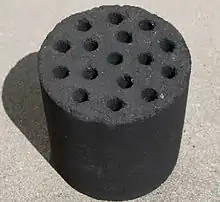Asian coal briquettes
Asian coal briquettes (Japanese: 練炭, Hepburn: rentan), also known by the names yeontan (Korean: 연탄) or fēngwōméi (Chinese: 蜂窩煤; Chinese: 蜂窝煤), are coal briquettes used in East Asia for cooking and home heating. They were first invented in Japan, then propagated through the rest of East Asia in the early 20th century, although they are now uncommon in Japan and South Korea.
| Asian coal briquettes | |||||||||
|---|---|---|---|---|---|---|---|---|---|
 | |||||||||
| Japanese name | |||||||||
| Kanji | 煉炭/練炭 | ||||||||
| Kana | れんたん | ||||||||
| |||||||||
| Chinese name | |||||||||
| Traditional Chinese | 蜂窩煤 | ||||||||
| Simplified Chinese | 蜂窝煤 | ||||||||
| Literal meaning | Beehive coal | ||||||||
| |||||||||
| Korean name | |||||||||
| Hangul | 연탄 | ||||||||
| Hanja | 練炭 | ||||||||
| Literal meaning | Kneaded coal | ||||||||
| |||||||||
| North Korean name | |||||||||
| Chosŏn'gŭl | 련탄 | ||||||||
Made from a mixture of lignite coal dust and a gluing agent that keeps the dust particles together,[1] they became a popular alternative to firewood and natural coal because they come in a consistent size and stack easily. There are 5 standard sizes for the briquettes, and the 2nd standard is widely used in households.
The 2nd standard briquette is cylindrical in shape, weighs 3.5 kilograms (7.7 lb), and is about 20 cm (7.9 in) in height and 15 cm (5.9 in) in diameter. The standard briquette has 22 holes drilled into its top to facilitate steady, efficient burning, and a household typically uses one to three briquettes per day in the winter. A new briquette can be placed on one that has been burned halfway to extend the burn time.
The same fire used for cooking also served to heat the house, through a Korean radiant underfloor heating system called ondol.
History by region
Korea
Introduced to Korea from Japan in the 1920s, yeontan rose in popularity following the Korean War. By 1988, 78% of Korean households used yeontan, but this fell to 33% by 1993 as people switched to oil and gas boilers, and was estimated to be used by just 2% of households by 2001.[1] The boilers reduced the risk of carbon monoxide poisoning, which was a major cause of death in coal-heated houses.[2]
In recent years amid South Korea's suicide epidemic, yeontan has seen use as a method of suicide by carbon monoxide poisoning.[3]
References
- "At Coalface of Heating from the Korea Times". koreatimes.co.kr. 21 June 2007. Archived from the original on 9 December 2018. Retrieved 21 December 2017.
- "[Korea Encounters] Yeontan briquettes opened windows while warming homes". koreatimes. 2019-03-12. Retrieved 2023-08-21.
- "Jong-hyun Dead, K-Pop SHINee Singer Dies, Apparent Suicide". 18 December 2017. Archived from the original on 21 April 2018. Retrieved 10 April 2018.